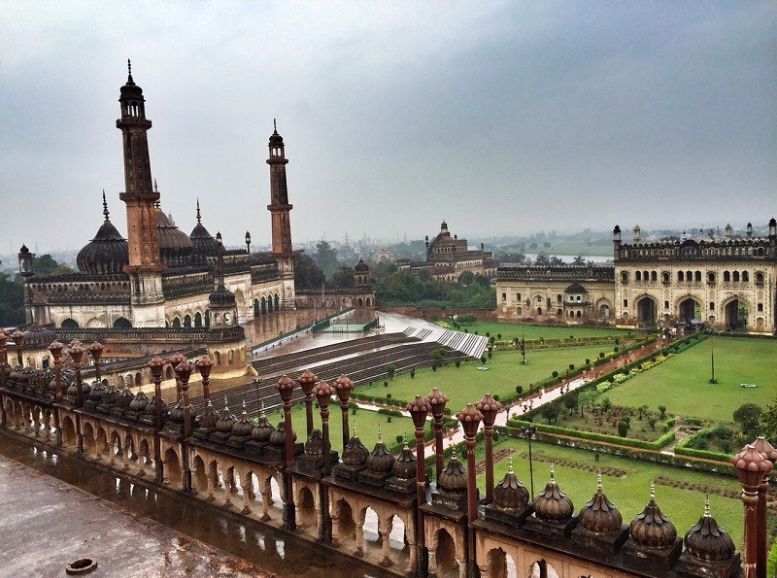Bada Imambara: Unveil the secrets of Lucknow, the City of Nawabs, where history whispers through its grand architecture and vibrant cultural tapestry. At the heart of Uttar Pradesh’s capital city lies a breathtaking monument, a testament to the magnificence of the Mughal era – Bada Imambara.
This iconic landmark, also known as Asafi Imambara, beckons visitors from across the globe. They come to marvel at its architectural mastery and delve into its rich history. Erected in the 18th century by Nawab Asaf-ud-Daula, the fourth ruler of Awadh, Bada Imambara transcends its architectural brilliance. It embodies the cultural heritage of Lucknow and whispers tales of a bygone era steeped in opulence.
Prepare to embark on a captivating exploration of Bada Imambara. We’ll unravel the intricate details of its design, unearth the legends woven around its construction, and discover the profound cultural significance it holds for Lucknow.
How to reach:
- Air: Lucknow boasts excellent air connections. Chaudhary Charan Singh International Airport is the closest airport, situated roughly 15 kilometers from Bada Imambara. Taxis and app-based ride-hailing services are readily available at the airport to whisk you to the monument. Expect the journey to take 30-45 minutes depending on traffic conditions.
- Train: Lucknow’s extensive rail network connects it to major Indian cities. Lucknow Junction Railway Station (officially Lucknow NER) is closest to Bada Imambara. Taxis and rickshaws are easily found at the station for the short trip, which typically takes 15-20 minutes.
- Road: Lucknow’s well-maintained roads make reaching Bada Imambara by road convenient. You can choose to drive yourself, hire a taxi, or utilize the city’s public bus network. Buses connect various parts of the city to Bada Imambara.
- Local Transport: Upon arrival near Bada Imambara, a variety of local transportation options are available, including cycle rickshaws, auto-rickshaws, and taxis. If you’d like to explore the surrounding area at your own leisure, walking is also a pleasant option.
Best time to visit:
October to March (Winter):
- The winter months, from October to March, are the best time to visit Bada Imambara and Lucknow.
- The weather during this time is pleasant with temperatures ranging from 10°C to 25°C, making it perfect for exploring the city’s attractions.
- The cool and dry weather makes it comfortable to explore the monument and its surroundings without feeling too hot or too cold.
- The winter months also coincide with the festival season in Lucknow, and you can witness various cultural events and festivals during this time.
April to June (Summer):
- The summer months, from April to June, experience hot and dry weather in Lucknow, with temperatures soaring as high as 45°C.
- Visiting Bada Imambara during the summer months can be challenging due to the scorching heat, making it uncomfortable for outdoor activities.
- If you plan to visit Bada Imambara during the summer months, make sure to carry plenty of water and wear light and breathable clothing to stay comfortable.
July to September (Monsoon):
- The monsoon season, from July to September, brings heavy rainfall to Lucknow, making it prone to waterlogging and flooding.
- Visiting Bada Imambara during the monsoon season can be challenging due to the unpredictable weather and the possibility of heavy rains.
- While the city looks lush and green during the monsoon season, it is advisable to check the weather forecast before planning your visit and to carry an umbrella or raincoat.
Attractions:
Bhool Bhulaiya (Labyrinth):
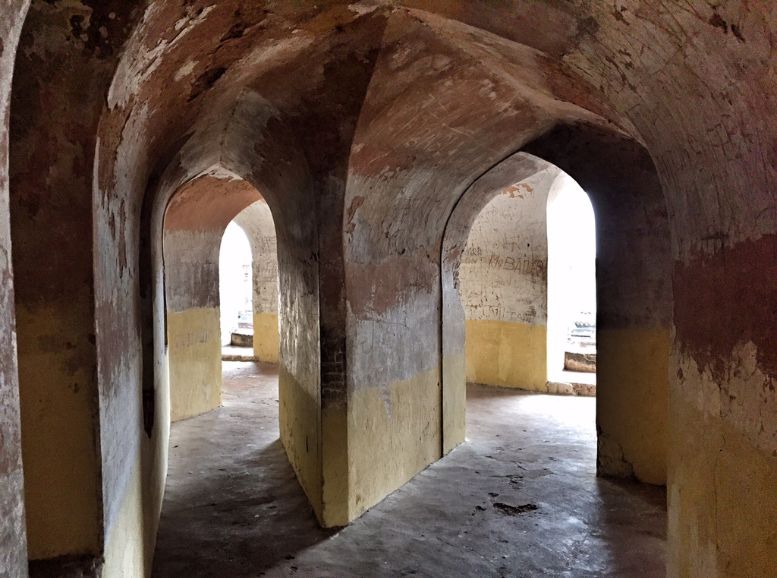
Step into the enigmatic Bhool Bhulaiya, a captivating labyrinth nestled within the Bada Imambara complex. Erected in the 18th century, this architectural marvel is a maze of narrow passages and hidden staircases, considered one of the world’s largest labyrinths. For centuries, it has challenged visitors with its intricate pathways and secret nooks. Put your navigational skills to the test as you weave through the corridors, and keep your eyes peeled for hidden surprises! Atop the Bhool Bhulaiya lies a breathtaking reward – panoramic vistas of Lucknow sprawl out before you. This unforgettable experience makes the Bhool Bhulaiya a must-do for any Lucknow adventure.
Asfi Mosque: Bada Imambara
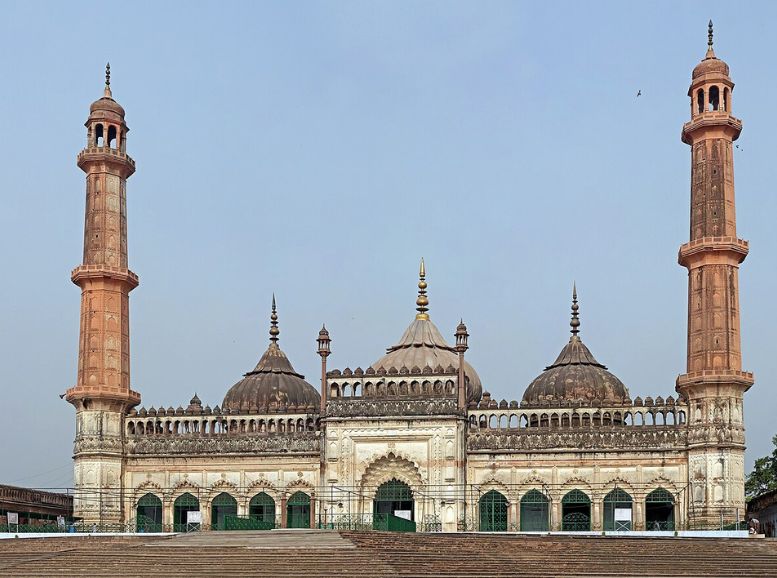
Within the Bada Imambara complex lies a gem of Indo-Islamic architecture, the Asfi Mosque. Nawab Asaf-ud-Daula commissioned its construction in 1784, and it stands as a testament to his vision and the era’s artistic brilliance. As you step inside, be captivated by the interplay of elegant domes, intricate carvings, and towering minarets. The mosque’s serene atmosphere invites quiet contemplation, while its design embodies the grandeur of Mughal artistry. No wonder it continues to draw visitors from across the globe.
Shahi Baoli (Royal Stepwell):
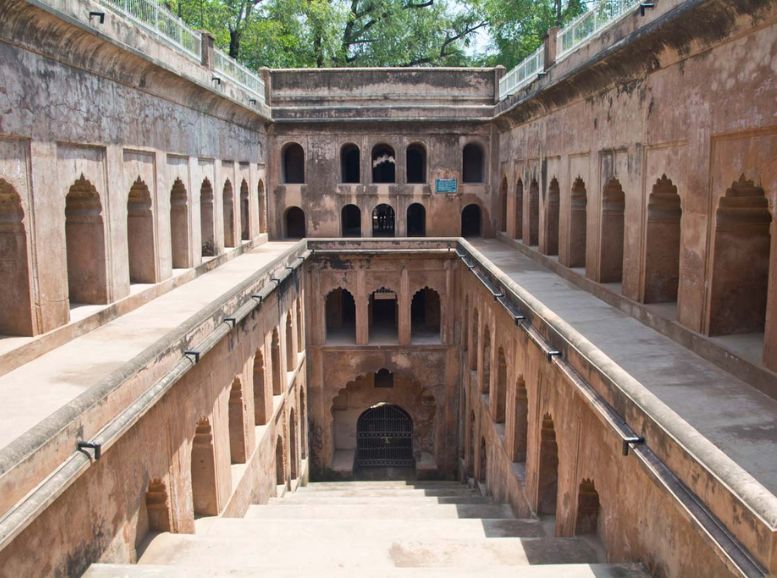
Journey down into history at the Shahi Baoli, an ancient stepwell nestled within the Bada Imambara complex. Built in the 18th century, this marvel of engineering wasn’t just a source of water for the residents – it was their lifeline. Descend the stepwell’s tiered passageways and be captivated by the intricate design. Elegant arches and beautiful carvings adorn the walls, whispering tales of the Mughal era’s artistic prowess and craftsmanship.
Naubat Khana (Drum House):
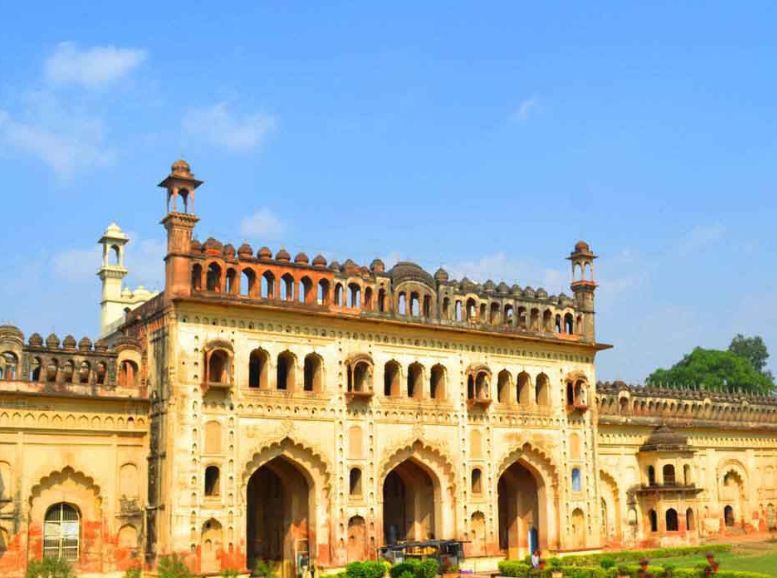
Standing sentinel near Bada Imambara’s entrance is the Naubat Khana, once known as the Drum House. Erected in the 18th century, this architectural gem echoed with music, its melodies heralding the arrival of the Nawab. Intricate carvings, graceful arches, and impressive domes adorn the Naubat Khana, transporting you back to the opulent Nawabi era. This historic landmark stands as a testament to a bygone era’s grandeur and is a must-see for any Bada Imambara exploration.
Central Hall (Bara Hall):
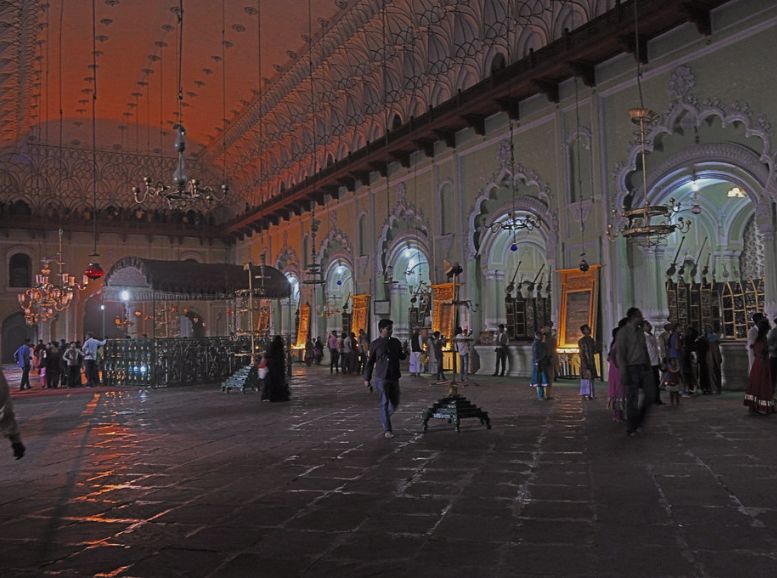
Be awestruck by the Bada Imambara’s heart, the majestic Central Hall, also known as Bara Hall. Erected in the 18th century, this magnificent space transcended its function as a venue for gatherings and ceremonies. Soaring ceilings, elegant columns, and sparkling chandeliers create a truly awe-inspiring atmosphere. Adding to the hall’s significance, it serves as the final resting place of Nawab Asaf-ud-Daula, the visionary behind Bada Imambara. As you explore this architectural gem, breathe in the rich history and cultural heritage that permeate every corner.
Local Experiences:
A Walking Tour
Embark on a captivating journey through Lucknow’s rich past with a heritage walk around Bada Imambara. Weave through narrow lanes and vibrant bazaars, marveling at architectural gems like Rumi Darwaza and Chota Imambara. Interact with friendly locals, savor delectable street food, and gain insights into the city’s fascinating history from knowledgeable guides.
The Awadhi Food Trail
Tantalize your taste buds with a flavorsome exploration of Awadhi cuisine on a food trail around Bada Imambara. Sample succulent kebabs, aromatic biryanis, and melt-in-your-mouth desserts at legendary eateries. Explore hidden gems serving authentic delicacies, leaving you craving more of Lucknow’s culinary magic.
Unveiling the City by Rickshaw
Hop on a traditional cycle rickshaw for a unique perspective of Lucknow’s vibrant streets. Take a leisurely ride past Bada Imambara, discovering hidden gems and local landmarks along the way. Engage with friendly rickshaw pullers, learning about their lives and experiences.
The Sound and Light Show
Witness the rich history of Bada Imambara come alive with a mesmerizing sound and light show. Watch the monument transform with colorful lights and captivating narrations that bring to life the story of Nawab Asaf-ud-Daula and its construction. Immerse yourself in stunning visuals, enchanting music, and captivating storytelling.
Markets and Boutiques
Delve into the vibrant markets near Bada Imambara, a treasure trove of traditional chikan embroidery, handcrafted jewelry, and unique souvenirs. Explore iconic shopping destinations like Hazratganj and Aminabad, browsing a diverse range of shops offering everything from local fashion to home décor. Interact with artisans, learn about their crafts, and find treasured mementos of your Lucknow adventure.
Live Performances
Immerse yourself in the vibrant tapestry of Lucknow’s culture with live performances of traditional music, dance, and theater near Bada Imambara. Witness captivating displays by local artists showcasing the city’s rich heritage. From classical dance to soulful music concerts, there’s always an experience waiting to leave you enchanted.
Travel tips:
Plan Your Visit: Bada Imambara’s popularity translates to crowds, especially during peak seasons. Plan ahead to avoid long queues and ensure a smooth experience.
Dress Modestly: Remember, Bada Imambara is a religious site. Respect local customs by dressing modestly. Opt for clothing that covers your shoulders and knees.
Comfortable Shoes are Key: Bada Imambara’s vast grounds and maze-like corridors demand comfortable footwear. Choose shoes that can handle uneven surfaces with ease.
Stay Hydrated and Fueled: Pack a refillable water bottle to stay hydrated, especially during hot weather. Consider bringing snacks to keep your energy levels up throughout your exploration.
Respectful Exploration: As a guest, be mindful of local customs and traditions. Remove your shoes before entering the main hall, and cover your head if necessary. Avoid pointing your feet at religious objects or people.
Enhancing Your Experience: Consider hiring a licensed guide from a reputable agency. Their knowledge can unlock the monument’s history, architecture, and legends, enriching your visit.
Beat the Crowds: Arrive early to explore Bada Imambara at its most serene. You’ll have ample space to wander and appreciate the cooler morning temperatures.
Respect Photography Rules: Photography limitations might exist in specific areas, particularly the main hall and Bhool Bhulaiya. Adhere to posted signage and avoid taking photos where prohibited.
Stay Cool, Stay Hydrated: Lucknow’s summers can be scorching. Ensure you stay hydrated throughout your visit by carrying a refillable water bottle and drinking frequently.
Explore Further: Bada Imambara’s central location offers easy access to nearby gems like Rumi Darwaza, Chota Imambara, and the Clock Tower. These landmarks provide a deeper understanding of Lucknow’s rich tapestry.
Beware of Touts: You might encounter touts or unauthorized guides offering their services. For a safe and informative experience, opt for licensed guides from reputable agencies.
Conclusion
Unveiling Lucknow’s soul goes beyond the history books. A visit to Bada Imambara with Xplro.com becomes a portal to the city’s vibrant past. Get lost (or found!) in the legendary Bhool Bhulaiya maze, marvel at the majestic Asfi Mosque, and witness the architectural and artistic mastery of the Mughals firsthand. Wander the sprawling complex, awestruck by intricate carvings, rich history, and sheer grandeur. But Bada Imambara is more than just a monument; it’s a beating heart of Lucknow’s culture. Encounter local artisans, musicians, and storytellers keeping the city’s vibrant traditions alive. History buff, architecture aficionado, or curious adventurer, Bada Imambara offers something for everyone. Visit Xplro.com to plan your Lucknow adventure and unlock the magic of Bada Imambara!
FAQs
1. What is Bada Imambara and where is it located?
- Bada Imambara, also known as Asafi Imambara, is a historical monument situated in Lucknow, the capital city of Uttar Pradesh, India. It was constructed by Nawab Asaf-ud-Daula in the 18th century as a part of a relief project during a severe famine.
2. What is the significance of Bada Imambara?
- Bada Imambara is one of Lucknow’s most significant historical and architectural landmarks. Renowned for its grand architecture, intricate design, and historical importance, it is a must-visit destination for tourists and history enthusiasts.
3. What are the main attractions at Bada Imambara?
- The main attractions at Bada Imambara include Bhool Bhulaiya (the labyrinth), Asfi Mosque, Picture Gallery, Shahi Baoli (Royal Stepwell), Naubat Khana (Drum House), Shahi Hamam (Royal Bath), and the Central Hall (Bara Hall).
4. What is Bhool Bhulaiya, and why is it famous?
- Bhool Bhulaiya is a labyrinth of narrow passages and secret staircases within the Bada Imambara complex. Famous for its unique architectural design and confusing layout, it is easy to get lost inside, adding to its allure and intrigue.
5. Is it true that Bhool Bhulaiya has 1,024 ways to reach the roof?
- Yes, Bhool Bhulaiya is said to have 1,024 ways to reach the rooftop. However, only one of these passages is the correct way out, making it a challenging maze to navigate.
6. Can visitors explore Bhool Bhulaiya on their own, or do they need a guide?
- While visitors can explore Bhool Bhulaiya on their own, it is recommended to hire a guide for a more enriching experience. Guides can help visitors navigate the maze-like corridors and share interesting stories and facts about the monument.
7. Are there any photography restrictions at Bada Imambara?
- Photography is allowed in most areas of Bada Imambara, but there are restrictions in certain areas such as the main hall and the Bhool Bhulaiya. Visitors are advised to respect signage indicating photography restrictions and avoid taking photos where prohibited.
8. Is there an entrance fee to visit Bada Imambara?
- Yes, there is an entrance fee to visit Bada Imambara. The fee varies for Indian and foreign tourists and may also include additional charges for visiting certain areas such as the Bhool Bhulaiya.
9. What are the best times to visit Bada Imambara?
- The best times to visit Bada Imambara are during the winter months, from October to March, when the weather is pleasant and ideal for sightseeing. It’s also advisable to visit early in the morning to avoid crowds and long queues.
10. How can visitors reach Bada Imambara?
- Bada Imambara is easily accessible by various modes of transportation. Visitors can reach it by air, via Chaudhary Charan Singh International Airport, by train, via Lucknow Junction Railway Station, or by road, via public or private transportation.
11. Are there any nearby attractions that visitors can explore?
- Yes, there are several nearby attractions that visitors can explore, including Rumi Darwaza, Chota Imambara, Clock Tower, and the markets of Hazratganj and Aminabad, which are known for their vibrant atmosphere and shopping options.
12. Can visitors attend the light and sound show at Bada Imambara?
- Yes, visitors can attend the mesmerizing light and sound show held in the evenings at Bada Imambara. The show narrates the history and legends associated with the monument and offers a unique and immersive way to learn about the history and culture of Lucknow.




